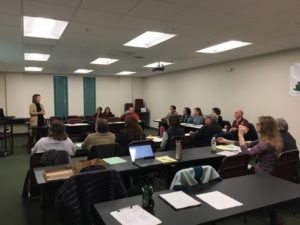Solano Local Food Advisory Board Final Meeting
By Stephanie Oelsligle Jordan, Local Food Program Manager
 On Feb. 5, 2019, the Local Food Advisory Board met for their final meeting during Sustainable Solano’s USDA LFPP planning grant (for a current list of Advisory Board members, click here). Led by Elena Karoulina, the meeting covered an overview and findings of the nearly completed feasibility study (including recommendations) and next steps. There was also a brief call for final suggestions on the feasibility study, and a discussion on how the Advisory Board might move forward as a “Solano Local Food System Alliance.”
On Feb. 5, 2019, the Local Food Advisory Board met for their final meeting during Sustainable Solano’s USDA LFPP planning grant (for a current list of Advisory Board members, click here). Led by Elena Karoulina, the meeting covered an overview and findings of the nearly completed feasibility study (including recommendations) and next steps. There was also a brief call for final suggestions on the feasibility study, and a discussion on how the Advisory Board might move forward as a “Solano Local Food System Alliance.”
As we know, there have been two main deliverables for this grant: 1) a feasibility study and 2) a business plan for Community Food Centers. Results from the feasibility study showed that there are several obstacles for creating Community Food Centers at this point in time, including lack of coordinated engagement, interest and trust among farmers; lack of public awareness/interest in a local food system; and challenges in demonstrating the value of a local food system to the community. There also remain challenges with distribution of farm products, and county-level agritourism policies that are not conducive to promoting farms who wish to connect with their surrounding communities. As a result, Sustainable Solano has notified USDA of this change, and will suggest submitting a Strategic Plan of Action in place of the business plan for Community Food Centers.
At the same time, several Advisory Board members acknowledged that by creating this space for collaboration among stakeholders, we have accomplished a great deal. And, there is room for growth here — all agreed that we should expand and diversify the Advisory Board, so there are representatives from institutional customers, economic development, food assistance, etc., and work to transform the Advisory Board into a “Solano Local Food System Alliance.”
Over the course of the meeting, the group brought up several valid questions:
- Should we look to a regional food system, and not just within Solano County? (Should we reach out to neighboring farmers in Yolo and Sacramento Counties?) By combining supply from both regions – yet prioritizing products from Solano County – we would be better able to support institutional demand and create a stronger farm-to-institution program within Solano County.
- What rules/regulations need to be changed so that farmers markets within Solano County can better support Solano-based farmers? (This question came up after a lively discussion on the barriers that farmers face to participate in Solano County farmers markets.) Interim Agricultural Commissioner Jose Arriaga had great information and insight from his past work with farmers markets in San Diego. This topic will be addressed in a separate meeting.
- How do we harmonize environmental, economic and social needs within a local food system so that it really does work for everyone? This is the million-dollar question! Food systems are very complex, and as we work toward the creation of one in Solano County, we will aim to balance these three pillars, and hold this question as the “guiding star” of our work.
- While a food hub does not seem feasible at this point in time, are there existing models that are operating sustainably? If so, can we adopt any of their practices to our situation? Yes! We are always looking at other models from which to glean information, processes, etc. Additionally, we seek to amplify and support existing, successful models/businesses in the county that are already participating in a local food system.
Everyone agreed that the next major step is to build infrastructure among the farmers. Our proposed action plan includes setting up channels for farmer input/feedback, creating a separate communications plan to raise public awareness of Solano farms/farmers, identifying technical assistance opportunities for small farmers (which could be offered via CAFF and other organizations) and seeking funding from the California Department of Food and Agriculture, which would support both public awareness/education and linking farmers to institutions (i.e. hospital cafeterias). We will also strive to learn more about the food assistance system within the county (i.e. EBT, Market Match) and what opportunities/challenges affect getting local food through these channels.
We look forward to working with our Solano Local Food System Alliance on these next steps, as we hold to the vision for an environmentally sustainable, economically viable and socially just local food system in Solano County.

